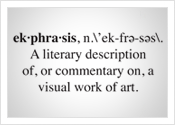
ekphrasis ii: sarah z. sleeper (mfa '12)
The Bellarmine Museum
July 11 - September 28, 2012
ek•phra•sis. n.'ek-frə-səs\. A literary description of or commentary on a visual work of art.
Holding the ancient technique of responding through the written word to visual works of art ("ekphrasis") at its core, this show provides an exciting platform for graduate students in Fairfield University's MFA in Creative Writing program. This year Sarah Sleeper (MFA '12) responds in prose to four works by Everett Raymond Kinstler, four works on loan from the Metropolitan Museum of Art and one piece in the museum's permanent collection.
Morning, Portugal
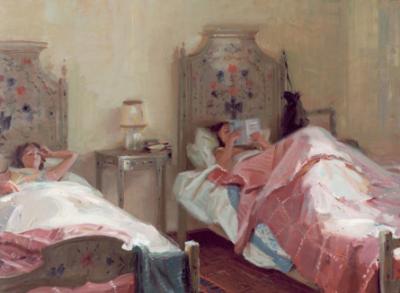
© Everett Raymond Kinstler, Morning, Portugal, 1990. Oil on canvas
Crowned by flowers and Alexander's cross,
blessed awake by melancholy fado floating up from the street,
unready to relinquish slumber's comfort to spin up, outside and into the glaring day.
Pastel skin glows, animated by brushed strokes of diffused sun,
beautiful buds growing from rosy stems of soft cotton and down.
I can't help but ask, does morning's glory read
Vicente's satires,
Sophia's poems,
or Saramago's novels?
And do words on paper make the coming day seem pale and passionless when compared?
How can prego or Porto compete with the illuminated page?
José knew that love is the light. Sophia found her truth in God. Vicente made his tithes to honor both the dark and light and claimed, "The pursuit of love is like falconry," and influenced Garcia Marquez and one hundred others to pursue it anyway.
I wonder, do Ray's girls find their personal sublimation in watercolor and oil?
© Sarah Z. Sleeper
Good Ol' Boys
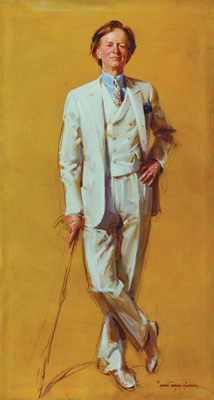
© Everett Raymond Kinstler, Portrait of Tom Wolfe, 1987. Oil on canvas
My father lived a second life in the stories of Wolfe, Hemingway and Kerouac - the electric ones, the war ones, the love ones, the drug-and-sex ones, the smart ones, the art ones, the sparse ones, the exclamatory ones, the run-on ones - and he told me so, so, so, so, so, so, so, so, so and so many times, and he mixed them together with his own stream-of-consciousness New Journalism-version of the late '50s, when his life was better than best, all golden and glowing and fruit-ripe and he slept in vineyards in France and learned to love Châteauneuf-du-Pape that he crammed down his throat and mine. I turned away from flak-jacket-and-guns Papa, free-love-and-drugs Jack, and natty, smarty move-to-New-Yorker Tom. Dad wanted to live those lives, not be tied up and down in Lake Forest, on the wrong side of the editorial wall at the Sun Times where poetry wasn't the currency and money was. Dad tried, with summers at Ernie's abandoned Walloon, pitiful Midwest road trips, and old fashioneds at the Algonquin. I couldn't make it through an English degree without reading A Farewell to Arms and I couldn't claim myself as a writer if I didn't know On the Road and The Right Stuff. (If I read with a concrete heart did the words enter?) When my father died, I found a laminated card hidden in his wallet. It said, "Do not stand at my grave and weep," but I wept anyway for all that he had wanted to be and wasn't and for my stubborn slowness in knowing the man he was in full. Then I moved his library into mine. Now his lost dreams live with my inspirations, and Wolfe, Hemingway and Kerouac cohabitate and comingle with Fitzgerald, Nabokov, Roy, Munro, Marquez and Erdrich. And my heart is no longer stone; it's a golden and glowing fruit-ripe ball of love for my father and his heroes. I've read all three of those good ol' boys from cover to cover and their words came all the way in.
© Sarah Z. Sleeper
The Sea Witch

© Everett Raymond Kinstler, The Sea Witch, 1958. Ink and gouache on paper.
Your magic trick was heads-down smarts and unedited aspirations. You knew the clipper better than most because you snatched-it-from-thin-air-created-it-from-whole-cloth-invented-it-out-of-the-clear-deep-blue of New York Public Library's best stacks. No matter that you'd never seen it with your eyes, you captured it with your young boy's imagination, your teenager's ambitious heart, and your sensible businessman's mind. Grizzled captain, frozen slicker, wooden grip fixed on wooden wheel, tilting into the stinging spray, worried eyes shadowed by soggy brim, ship heeling and tacking toward its namesake-mermaid-silky-muse-demise lurking just below the next set of whitecaps. Swollen sails, swirling currents, gull-vultures in the Witch's wake. Who but you could have imbued this novel scene with such mysterious and fearful authority? The Murrays and their men were constrained by rocky shores, shallow reefs, treacherous troughs and swells and the need to breathe everyman's air. You dove into the ocean, within and beyond it, unconcerned by the moon, the tides, the winds or enchanted shells or sea glass. A half-century on, Laing would still choose for his beauty's story to be rendered by your deft artist's hands instead of retold in muttered mythologies from any anchor-armed seaman.
© Sarah Z. Sleeper
Art Lover
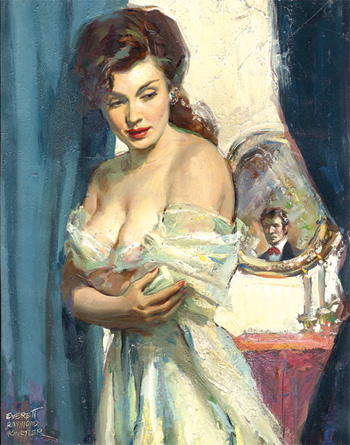
© Everett Raymond Kinstler, Women in Love, 1955. Oil on canvas.
Gudrun's dress is sheer, loose, to slip off with a whisper, her hair is soft-coiffed to tumble by touch, her mouth and fingernails are rosy and ready, her earrings embellish and mimic propriety. Her face tells the story - sidelong half-mast gaze, lips parted in anticipation. No distractions to this passion, only woman, man, candlelight and curtains. Gerald's stock-still in the glass, diminished by the enormity of her brazen seduction. Can a look or a book be profane? Can a person? Can an image in oil? Certainly not GI-Jane Russell, who had arched eyebrows and cheekbones and whose cleavage for days D.H. never saw, but served as twin stars of cinema verité for the boys of New York. Some preferred blondes, but brunettes enticed too. In this cover do I detect Dorothy Shaw? Does it harken to Rio McDonald's publicity still? It's desire-made-with-paint, what Men in Love want to see. She's luminous and gorgeous and 38 Triple-D.
© Sarah Z. Sleeper
Bequeathed to Seamus Heaney
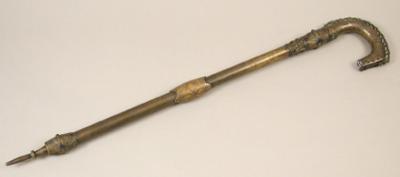
Crozier of Clonmacnoise, Irish, 11th century (reproduction).
Bronze, silver inlay, gilt, gem stones. Lent by the Metropolitan Museum of Art, Rogers Fund, 1908 (08.23.34)
Resurrected, the bishop's crozier is gilded and girded with ribbons, snakes, hounds and horrors, and grey with the oppression of age and occupation; dull bronze, dirty silver and unroyal blue and amber. It smells of peat and dust. St. Ciarán decried and denied his monastery's fated future when he exhaled and infused divine inspiration into this once dazzling staff, refusing to believe in the end. Clonmacnoise had broken Ciarán's immortal heart six times by the time the artisan started his work, and his heart would break ten times more, century by century, after his ascension. He shivered in his heavenly robes as marauding Vikings and bloody Normans ravaged the bodies and souls of his congregation. He wept at the upright iron will of the Brits, bent on reform and conformity, and at the tombstone cold clouds that obscured the Offaly skies. He mourned the last living days of his beloved meadow, which Athlone would surpass and impoverish. With a profusion of tears he flooded away his earthly remains so that excavators found nothing but salt and sand. On the day the crozier was reborn, Ciarán whispered devotions to his sons to remind them that God's shepherd will poke and prod the slothful and faithless, stand firm with the loyal flock, claw and draw back into the fold those who stray, and slay Satan's encroaching dragon as it slithers down the Shannon. As Elizabeth takes her jubilee to the North, St. Ciarán bequeaths the crozier to Seamus Heaney, who, like the bishops of Clonmacnoise, is philosopher and king and would never raise his chalice to toast the Queen.
© Sarah Z. Sleeper
Holy Bones
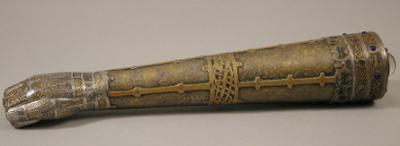
Shrine of Saint Lachtin's Arm, Irish, 1106 (reproduction).
Bronze, silver, gem stones. Lent by the Metropolitan Museum of Art, Rogers Fund, 1908 (08.233.7)
Holy bones bring the faithful to their knees. One thousand years ago, St. Hugh severs a finger from Mary Magdalene's arm and absconds with it from France to England. In the sixteenth century, nuns from Salamanca bury the body of St. Teresa under immovable stones so it can never be returned to Avila. In the nineteenth century devout New Yorkers barricade themselves inside a church with a relic from St. Anne, steadfast until they get their piece, her body divided up so that many can share the holy bones experience. At his death in 622, St. Lachtin was pious, learned and humble, and believers worshipped his arm, enshrined it in bronze, silver and precious stones, preserved it for posterity. Though this reliquary is empty, devoid of time-leathered flesh or marrowless bone, and though it is encased in impenetrable museum glass, will you fall on your knees in gratitude for its enduring and divine beauty?
© Sarah Z. Sleeper
Disgrace of Desiderata
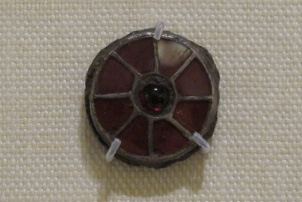
Cloisonné Disk Brooch, Frankish, 6th century.
Silver, garnets with patterned foils Lent by the Metropolitan Museum of Art,
Gift of J. Pierpont Morgan, 1917 (17.191.148)
A pinwheel of garnet - beautiful, not precious - commissioned by Charlemagne for Desiderata - lovely, not loved. She affixed it to her silken wrap to obscure the spot where her décolletage could have been seen, had he looked. Did he order his jeweler to make the edges uneven, the triangles dull and flattened, equal to his affection? When he sent Desiderata away to Lombard, disgraced and defeated, did she hurl it, clattering stone on stone? Did the King of the Franks offer the child Hildegard a brooch of bloody rubies and royal blue sapphires? And did he rip it from her bosom and ruin her too?
© Sarah Z. Sleeper
Not Afraid of You
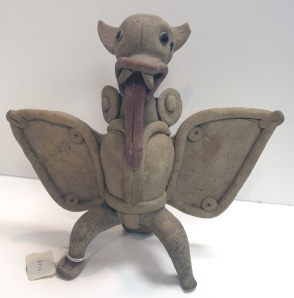
Winged Bat Figure, Mexican (Veracruz), 250-500 Terracotta.
Gift of Mr. and Mrs. Jacob Fass, 2002
Your squishy fish mouth gapes and stinks sour. Your cockeyed fangs need sharpening and couldn't pierce the skin of a zapote. Your tongue hangs listless, a limp impotent non-phallus, dangling ironically above your terracotta chastity belt. Olmecs and Aztecs spent terrified nights, afraid you'd escape from your cave, drag them to the devil's underworld, imprison them forever in the land of the dead. But you can't possibly hunt with those blind beetle eyes. And if your dense unfeathered wings don't deny you flight, your alien skull and hammerhead tail will nosedive you into the Pico de Orizaba, leaving Veracruz to its peace.
© Sarah Z. Sleeper
Penthesilea before Achilles
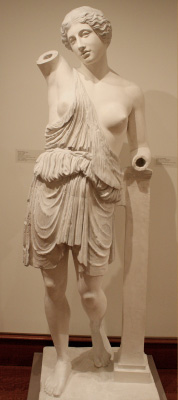
Attributed to Kresilas (Greek, active ca. 450-420 BCE)
Winged Bat Figure, ca. 440 BCE. Plaster cast from marble Roman copy of original Greek bronze. Lent by the Metropolitan Museum of Art
Penthesilea grieves for Ares and Otrera, a stony tear scars her right eye, the only chink in her flawless symmetry and perpetual, beautiful sadness. She's fearsome and battle-ready, a study of physical power and dispassionate restraint. Her lips part in silent lament and she raises her arm to reveal a flesh wound, the cut not deep enough to amputate the memory of her guilt. She's a brazen temptation to the Trojans, her heart unarmored for her deadly tryst with Achilles. Stripped of her weapons, her horse and her honor, she strides toward her suicide, bleeding nine rivers of blood for Hippolyta.
© Sarah Z. Sleeper